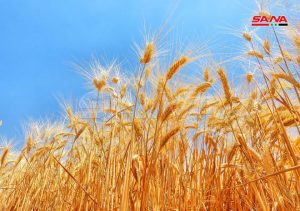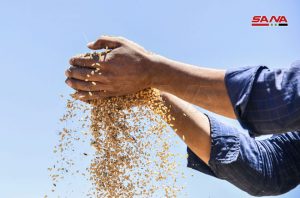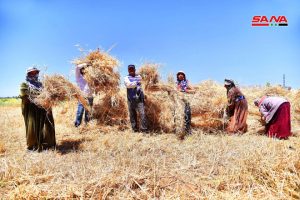Wheat has sacred symbolism due to its food security, economic stability, beloved social customs, unique religious rituals and immortal legends. The Syrians dealt with the grain of wheat on their own way, according to their regions, local environments and popular cultures, to turn it into a symbol of infinite intellectual and material bestowal. The Syrian grain of wheat, with its universal spirit, used as a motto for Syria’s pavilion in Expo 2020 Dubai.
It began when the human in Syria recognized wild wheat, and began his relative sedentary life close to the fields, consuming some of the crops and storing the rest. The book (The Mystery of Ishtar) by the great Syrian thinker Firas al-Sawah mentions that the cycle of nature has become of greater importance for human life after he had figured out wheat, so bread became part of his diet and changed his social customs.
al-Sawah asserts that the life of the Syrian peoples and their economic systems centered around the succession of seasons and the annual agricultural cycle. At the threshold of this stage, mythological themes assembled about the absence of (Ishtar) Mother goddess in the fall, and her return with the greenness of spring in the image of a coherent legend around which the religious life of the group centered, as well as its social life about bread production.
Therefore, the indigenous Syrians dealt with bread in some particular way, no matter the age, they all pick the fragments up of the ground and kiss it, as they all had a collective sense of the sanctity of bread.
The indigenous Syrian planted the first grain of wheat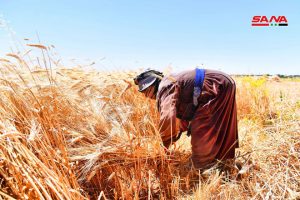
With reference to the historical archive, we see that man learned about planting and cultivation in the eighth century BC. Excavation missions concluded that agriculture was first practiced in the rain-fed plains and inland valleys in Syria and that was attested in “The Rise of Civilization: From Early Farmers to Urban Society in the Ancient Near East” by Charlez Fredman.
In 1965, a French excavation mission, conducted salvation excavations at the site (Tel al-Muribt) 100 km west of Raqqa threatened to be immersed by the Euphrates Dam. Thousands of important archaeological finds were restored, that attested the emergence of human settlement and the onset of agriculture in this region, and later spread all over the world to embody a decisive era in the history of humanity.
At Tel Hallulah, a small archaeological site on the Euphrates river south of the Syro-Turkish borders, a Spanish excavation expedition unearthed what was the first cultivated spike of wheat in the world cultivated by human at the site that dates back to (8500 BC).
Due to this find, the excavators and researchers recognized the historical value of Syria, and hastened the searching process in the oldest cultivation areas in Syria, particularly in the middle Euphrates, concluded that Syria is the homeland of agriculture, from where it spread all over the world.
Ugarit played a very influential role in the cultivation, storage and distribution of wheat all through the region, as was attested by the historical records. About this, the Syrian scholar specialized in Ugaritic civilization, Dr. Ghassan Al-Qayyim said in an interview with SANA, “of particular importance in these records is the essential role played by Ugarit in supplying Anatolia with foodstuffs, such as (wheat and barley), particularly during the eras of disruption and that of deterioration of international situation as a result of wars and invasions and was the food basket for all the adjacent regions”.
The Hittite king requested, in a letter the king of Ugarit, to protect a convoy of grain sent from (Mukesh) northwestern Syria to (Khati) in Cilicia “as it is a matter of life or death”, Al-Qayyim siad,
“Ugarit was also a major center for shipping foodstuffs”, this was attested by a text sent to the king of Ugarit by one of the notables of the Hittite state. And throughout its life-span Ugarit remained an open state, provided aid and assistance to all its neighbors and all the states with which it had political and commercial relations”.
The first scientific revolution Ugarit witnessed, was not the alphabet, but it rather was being a main exporter of the first agricultural wealth, and that was documented in the archaeological records and stratigraphic surveyed levels under the city, where grains were found at the lower stratas , date to middle eighth century BC.
Excavation missions in the ancient city found grains such (wheat, chickpeas, beans and barley), indicating that the first inhabitants of Ugarit, possessed the constituents of civilization and transformed from a negative exploiter of nature to a positive producer who harvested plants and domesticated animals and built rectangular and tall dwellings and had food stocks and was self-sufficient in food, animals and plants.
In the same context, historical research mention that the fertile plains of the Levant were the main supplier of wheat and agriculture products to the Roman Empire. Houran plain was identified a (Rome’s granary) as the Roman Empire fully depended on its agricultural products, particularly the wheat, and that encouraged the Romans to develop irrigation systems, dug canals and wells under the supervision of specialized engineers
Comparing now and then, specifically during the unjust terrorist war Syria was subject to, which destroyed the Syrian’s source of livelihood and subsistence during the past eleven years, the targeting of Syrian wheat, which threatens national food security, was not purely a coincidence, but rather it was a systematic approach.
A report by the FAO in Syria stated that wheat production in Syria before 2011 recorded 4 million tons, and the surplus was exported to neighboring countries and Europe due to its high quality.
The decline in wheat production during the years of war is due to many factors, including drought. The Turkish regime played a major role in this respect, where it cut off the flow of the Euphrates and its tributaries, which amounts to be genocide and crime against humanity as stated in articles of the International Law. Add to these, is fires ignited by terrorist organizations at each harvest season, looting of wheat by the American occupation forces and its affiliated conspirators, to convert the bread of the Syrian people as a tool to pressure the Syrian government, which constituted a new stage in the economic war against the peaceful Syrian people.
The decline in wheat production during the years of war is due to many factors, including drought, where the Turkish regime played a major role in this respect, where it cut off the flow of water, which amounts to be genocide and crime against humanity in accordance as stated articles of the International Law. Add to these is fires ignited by terrorist organizations at every harvest season and theft of wheat by the American occupation and its affiliated conspirators, to turn the bread of the Syrian people as a tool to pressure the Syrian government, which constituted a new stage in the economic war against the peaceful Syrian people.
Syrian wheat “the spirit of the Syrian land”
Despite what this important strategic crop has been subject to, the Syrian s’ view of wheat remains the same since he planted his first spike of wheat till today, as he believed in it, loved it and fed by it, and preserved its rituals. He has that spirit that dies every year to give us life.
Societal customs and the grain of wheat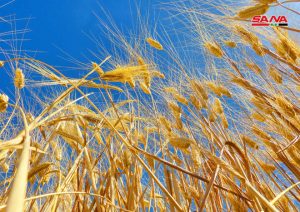
The Syrian maintained his relationship with wheat in the present as was in the past. Among these customs and rituals is al-Barbara Festival, on December 4, celebrated by Christian denominations in honor of the generous land, and the most important of its rituals is when families prepare sweets and cook (Harissa).
To commemorate the grains of wheat, according to Al-Qayyim “the celebrants light a pile of firewood in front of each house, in the Syrian countryside in particular, and circle around it. Proverbs said in al-Barbara Festival (in al-Barbara, love returned to a kuwara) a metaphor for the end of the cultivation process of the land and the need to return the grains that were not planted to their hideouts.
One of the popular social traditions carried out by Syrian families is the preparation of “Sliqa”, where wheat kernels are boiled after preparing (firewood) to lit the stoves. Women wash the kernels of wheat before putting them into large pots and fill them with water till they boil, while children, relatives and neighbors gather waiting for the wheat kernels to ripen to have a bowl full of “Sliqa” and add sugar to make it taste delicious.
The preparation of Al-Saliqa is preceded by cleaning the roof of the house to spread wheat on it for two or three days, then it is collected and they rid of the peddles. This is another social ritual in which Syrian communities are distinguished, where neighborhood girls gather to help, beautiful conversations filled with memories take place, and the place is filled with laughter.
The wheat spike and its spirit were posed inspiration to Syrian plastic artists who depicted nature in their paintings by drawing the harvest seasons, either directly in expressive or symbolic paintings. The photographers’ lenses documented this unique Syrian seasons.
It was also portrayed in kids’ stories, and manifested in theatrical performances, the latest of which was the presentation at the opening of (Jarih Al Watan) Sports Games signed of the great producer Najda Anzour.
The grain of wheat, with its generous spirit, is the motto of the Syrian Arab Republic’s pavilion in the UAE, in Expo 2020 Dubai, conveying a message to the whole world that Syria, which was the reservoir of the old world with its wheat, is today the spirit of the new world with its people who cultivate creativity and beauty in their homeland and spread knowledge and activity throughout the world.
Rasha Mahfoud /Amer Dawa
 Syrian Arab News Agency S A N A
Syrian Arab News Agency S A N A

